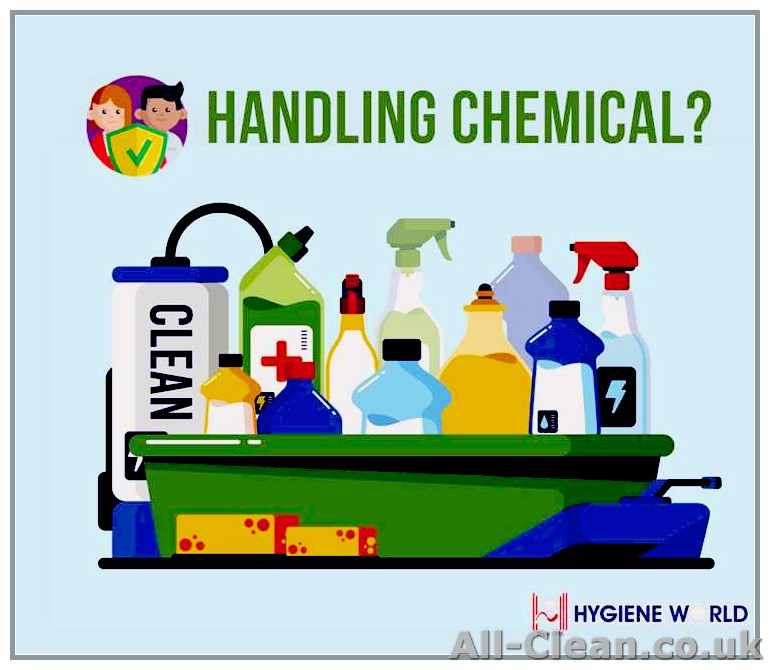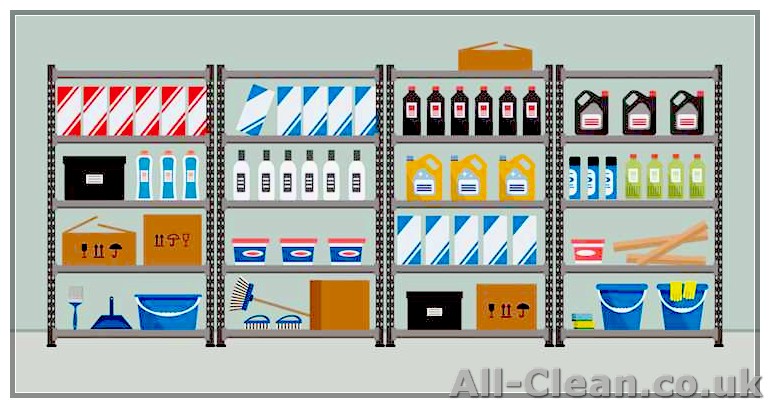
When it comes to dealing with chemicals in the workplace, it is essential to know how to store, handle, and clean them properly. Practically every organization uses some form of chemical cleaner, whether it’s for maintaining a clean and tidy workspace or for more specific purposes. However, to ensure the safety of your staff and the efficient operations of your business, it is important to follow certain guidelines.
First and foremost, organizing the storage and location of your chemicals is key. It is always best to store different types of chemicals in separate containers to prevent them from mixing or reacting with one another. Properly labeled containers are also essential for easy identification and documentation. This not only helps maintain standards within your workplace, but also protects against potential hazards.
When it comes to handling chemicals, training your staff is crucial. They should be well-versed in the proper dilution and usage of different chemicals. This will not only ensure the effective and efficient use of the products, but also minimize any risk or harm to themselves or others. Caution should always be exercised when handling hazardous chemicals, and proper protective gear should be worn at all times.
Cleaning chemicals should be stored in a cool and dry location, away from direct sunlight. Climate control is also important to prevent the spreading of hazardous fumes or chemicals. Chemicals should be stored in sturdy containers that are resistant to leaking or falling. It is also important to regularly check the expiration date of the chemicals and dispose of any expired or deteriorated products properly.
Overall, properly storing, handling, and cleaning chemicals is an essential aspect of maintaining a safe and efficient workplace. By following these tips and ensuring that your staff is trained in the proper use and precautions of different chemicals, you can protect your employees, your business, and the environment.
- Handling Cleaning Chemicals and Maintaining Storage Areas
- Storing Chemicals
- Handling Cleaning Chemicals
- Maintaining Storage Areas
- Effective Chemical Safety Program: Key to Success
- Storage and Handling
- Cleaning and Dilution
- Safety Signage and Infographics
- Tidy Cleaning Cabinet: Practical Storage Solution
- Choosing the Proper Location for Cleaning Chemicals
- Important Considerations
- Recommended Storage Locations
Handling Cleaning Chemicals and Maintaining Storage Areas

Safely handling and storing cleaning chemicals is an essential part of any cleaning program. It is important to take proper precautions to ensure the safety of yourself, others, and the environment. By following some basic guidelines, you can effectively maintain a chemical-safe workplace and reduce the risk of accidents and injuries.
Storing Chemicals
- Store cleaning chemicals in a designated area that is separate from other items.
- Organize chemicals by categories and use containers that are properly labeled.
- Ensure that chemicals are stored in a cool, dry location to reduce the risk of chemical reactions or degradation.
- Store hazardous chemicals in a spark-proof and climate-controlled area, if necessary.
- Train employees on properly storing and handling chemicals to prevent accidents.
Handling Cleaning Chemicals
- Read and follow the manufacturer’s instructions and safety data sheets (SDS) for all cleaning chemicals.
- Wear appropriate personal protective equipment (PPE), such as gloves and goggles, when handling chemicals.
- Use caution when diluting chemicals, as improper dilution can lead to ineffectiveness or danger.
- Never mix different cleaning chemicals together, as this can create harmful and potentially hazardous reactions.
- Only use cleaning chemicals for their intended purposes and follow recommended dilution ratios.
- Be cautious when handling cleaning chemicals near open flames or heat sources, as they can be flammable.
Maintaining Storage Areas
- Regularly inspect storage areas to ensure they are clean and free from spills or leaks.
- Clean up any spills or leaks immediately and dispose of them properly.
- Keep storage areas well-ventilated to prevent the buildup of fumes.
- Properly dispose of empty containers according to local regulations and guidelines.
- Keep documentation of chemical inventory and usage to track and monitor stock levels.
- Maintain a midlab program to efficiently manage and control cleaning chemicals within the workplace.
By safely handling cleaning chemicals and maintaining storage areas, you can protect yourself and others from harm and create a safe working environment. Remember to always follow proper procedures, use caution, and prioritize safety in all cleaning activities.
Effective Chemical Safety Program: Key to Success
An effective chemical safety program is crucial for ensuring the proper handling, storage, and cleaning of hazardous chemicals. Such a program not only prevents accidents and injuries but also promotes a safe and healthy environment at home or in the workplace.
Storage and Handling
When it comes to storing and handling chemicals, it is important to sort them properly. Keep hazardous chemicals away from non-hazardous ones to prevent any danger of cross-contamination. Ensure that chemicals are stored in appropriate containers with proper labeling and sealed lids. This prevents spills and limits exposure.
Tips for storing chemicals:
- Store chemicals in a cool, dry, and well-ventilated location to optimize their shelf life.
- Use a designated storage cabinet with proper ventilation and secure locks to keep chemicals safely stored.
- Group chemicals based on their compatibility and store them accordingly.
- Follow strict guidelines for storing flammable and reactive chemicals to prevent ignition or explosive hazards.
Cleaning and Dilution
Handling and cleaning chemicals require caution to avoid harmful exposure. When diluting chemicals, always follow proper instructions and use the correct ratios to ensure safe usage. This is especially important when working with concentrated detergents or cleaning formulations.
Tips for handling and cleaning chemicals:
- Read and follow the instructions on the product labels carefully.
- Wear protective gloves, goggles, and clothing when handling chemicals to prevent skin irritation or inhalation of fumes.
- Dispose of used chemicals and containers properly according to local regulations.
- Keep cleaning chemicals away from children and pets. Store them in a locked cabinet or high shelf.
Safety Signage and Infographics
One key part of an effective chemical safety program is the use of proper signage and infographics. This ensures that everyone in the area is aware of the potential hazards and understands how to handle and store chemicals safely.
Infographics can provide easy-to-understand instructions for various chemical handling and cleaning procedures. Signage should be posted in visible locations, such as in the bathroom or cleaning area, and should include information about the types of chemicals stored and any necessary precautions.
By following these essential tips and implementing an effective chemical safety program, the risk of accidents, injuries, and harmful exposure to chemicals can be significantly reduced. Whether at home or in the workplace, always prioritize safety and ensure that everything is well-organized and tidy.
Tidy Cleaning Cabinet: Practical Storage Solution
Proper storage of chemicals is essential for maintaining a safe and effective workplace. Optimal storage ensures that chemicals are easily accessible, sorted, and organized, preventing accidents and maximizing efficiency. A tidy cleaning cabinet is a practical storage solution that can be used to keep chemicals in a neat and orderly manner.
When choosing a cleaning cabinet, it is important to consider the size and layout of the cabinet. Choose a cabinet that is large enough to accommodate all of your cleaning supplies, but also fits within the available space. Additionally, consider the design of the cabinet and whether it has multiple compartments or shelves, which can help to keep chemicals organized and easily accessible.
Once you have a cleaning cabinet, it is important to carefully label and sort your chemicals. Use clear and concise labels to indicate the name of the chemical, its purpose, and any safety precautions that need to be taken. Group similar chemicals together, such as all-purpose cleaners or disinfectants, to make it easy to find what you need.
When storing chemicals in the cleaning cabinet, it is important to follow proper safety guidelines. Ensure that all chemicals are tightly sealed to prevent leaks or spills. Keep the cabinet away from direct sunlight, as prolonged exposure to sunlight can affect the effectiveness of some chemicals. Additionally, place hazardous chemicals on higher shelves to prevent them from being accidentally accessed by children or pets.
Another important aspect of storing chemicals efficiently is dilution. Dilute chemicals according to the manufacturer’s instructions and store the diluted solutions in clearly labeled containers. This not only helps to save space, but also prevents the risk of accidentally using a concentrated chemical.
Proper handling and cleaning of chemicals is crucial for maintaining a safe and healthy workplace. By implementing an organized and efficient storage system, you can ensure that your staff is trained to handle chemicals effectively and safely. Additionally, implementing a program that encourages staff involvement in the storage and handling of chemicals can further enhance workplace safety and sustainability.
If you’re in search of an innovative and effective cleaning cabinet that meets the highest standards of safety and sustainability, consider MidLab’s line of cleaning cabinets. Their carefully designed cabinets are made with the utmost caution to prevent spreading of hazardous chemicals and increase the efficiency of cleaning operations.
To learn more about proper storage solutions and best practices for handling and cleaning chemicals, follow us on Twitter: @midlabcom. Share your tips and insights with the hashtag #ChemicalStorageSolutions.
Choosing the Proper Location for Cleaning Chemicals

When it comes to storing and handling cleaning chemicals, choosing the right location is crucial for several purposes. The area where you store your chemicals should be tidy and clean, with proper storage facilities and easy access for your staff.
Important Considerations
There are several factors to consider when selecting a location for cleaning chemicals:
- Safety Standards: Ensure that the chosen area meets safety standards and regulations, such as having proper ventilation and being away from ignition sources.
- Climate Control: Some cleaning products may be sensitive to extreme temperatures, so consider a climate-controlled storage area to prevent degradation or freezing.
- Documentation and Information: Keep the safety data sheet and other documentation for each chemical within reach, ensuring that staff can easily access them when needed.
- Grouping: Group similar chemicals together and clearly label them to prevent mixing and potential chemical reactions.
- Hazard Identification: Clearly mark the area as a hazardous chemical storage location to alert staff and visitors about potential risks.
Recommended Storage Locations
Here are some suggested areas within your workplace where cleaning chemicals can be effectively stored:
- Bathroom Storage: If your workplace has a bathroom, allocate a storage area within it for cleaning chemicals. This is practical as it’s likely already a chemical-safe area and staff are familiar with its use.
- Midlab: If you have a dedicated cleaning area, such as a midlab, consider storing your chemicals here. This centralizes the storage and ensures quick access when needed during routine cleaning.
- Proper Shelving: Allocate a dedicated area with proper shelving or a storage cabinet for your cleaning chemicals. This ensures they are well-organized and placed in an open, easy-to-reach location.
- Flexible Areas: If your workplace has multiple cleaning areas or stations, consider having smaller cleaning chemical storage buckets or containers at each station. This saves time and increases the accessibility of the chemicals.
By following these storage tips and ensuring proper handling of cleaning chemicals, you can create a safer workplace environment and save time when these chemicals are needed.








